#Anaerobic Incubator
Explore tagged Tumblr posts
Text
Anaerobic Incubator
Anaerobic Incubator is meticulously engineered to create and maintain an environment devoid of oxygen, crucial for the cultivation and study of anaerobic microorganisms. The temperature range inside the chamber can be maintained from RT+3 to 60℃ with a microcomputer control system. This unit is tailored to ensure a consistently anaerobic environment, prioritizing both the integrity of experiments and operator safety.

2 notes
·
View notes
Text
Anaerobic Incubator
The LAI-A10 Anaerobic Incubator is a piece of laboratory equipment used to create and maintain anaerobic conditions for experiments or cultures that require an oxygen-free environment. Anaerobic incubators are crucial for growing microorganisms that thrive in environments devoid of oxygen. They typically feature airtight chambers with controlled atmospheric conditions, including temperature, humidity, and gas composition, usually containing a mix of nitrogen, carbon dioxide, and sometimes hydrogen to create the anaerobic environment required.
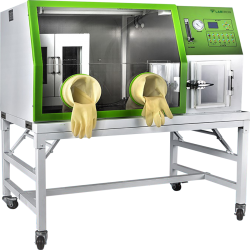
0 notes
Text
Anaerobic Incubator

Anaerobic Incubator features an LCD display, automatic humidity control, sleeve gassing, external vacuum pump, and power socket. It generates an anaerobic environment within 5 minutes and less than 1 hour, with a high efficiency palladium catalyst for oxygen concentration control. Shop online at Labtron.us
0 notes
Text
Anaerobic Incubator ± 3 % RH

Labtron Anaerobic Incubator featuring a microprocessor control system and UV sterilizer. It establishes anaerobic conditions in under < 5 min, operates within a temperature range of RT+3 to 60 °C, and includes safety features such as leakage protection and an overheating alarm.
0 notes
Text
A list of equipment in Luis Serra's lab and what he might use them for
My beloved mutual @geddy-leesbian put in a ton of effort and got these incredibly detailed screenshots of Luis's island lab, featured in this post, and I thought I would follow that up by comparing what he uses to what I use in my own lab. This was fun for me to do and I also thought it could be used as a resource for any writers that aren't as familiar with Luis's profession.
(for context if you don't know me, I am a microbiologist, bacterial geneticist if you want to be specific. I'll be earning my PhD hopefully this year, and I have been studying biology for 10 years, and actively working in various labs for 7)
Obviously this is a science fiction video game, so while I may be a scientist, I am still using some level of guesswork! This is just meant to be a fun little thing for my fellow resi nerds.
1. Liquid Nitrogen tank


These are used for flash-freezing biological samples for long-term storage. In the context of Luis’s research, he might flash-freeze plaga cells or dead plaga bodies in order to store them (typically at -80 Celsius) without them decaying or being damaged
2. Microcentrifuge
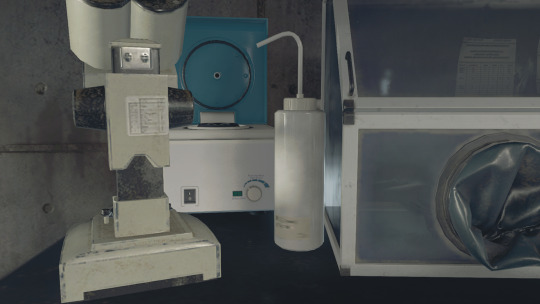

This is a veryyyyy common piece of equipment. You use them to spin samples so you can collect cells out of suspension. It’s like how they spin blood to separate it from plasma at blood donation centers
3. Light microscope
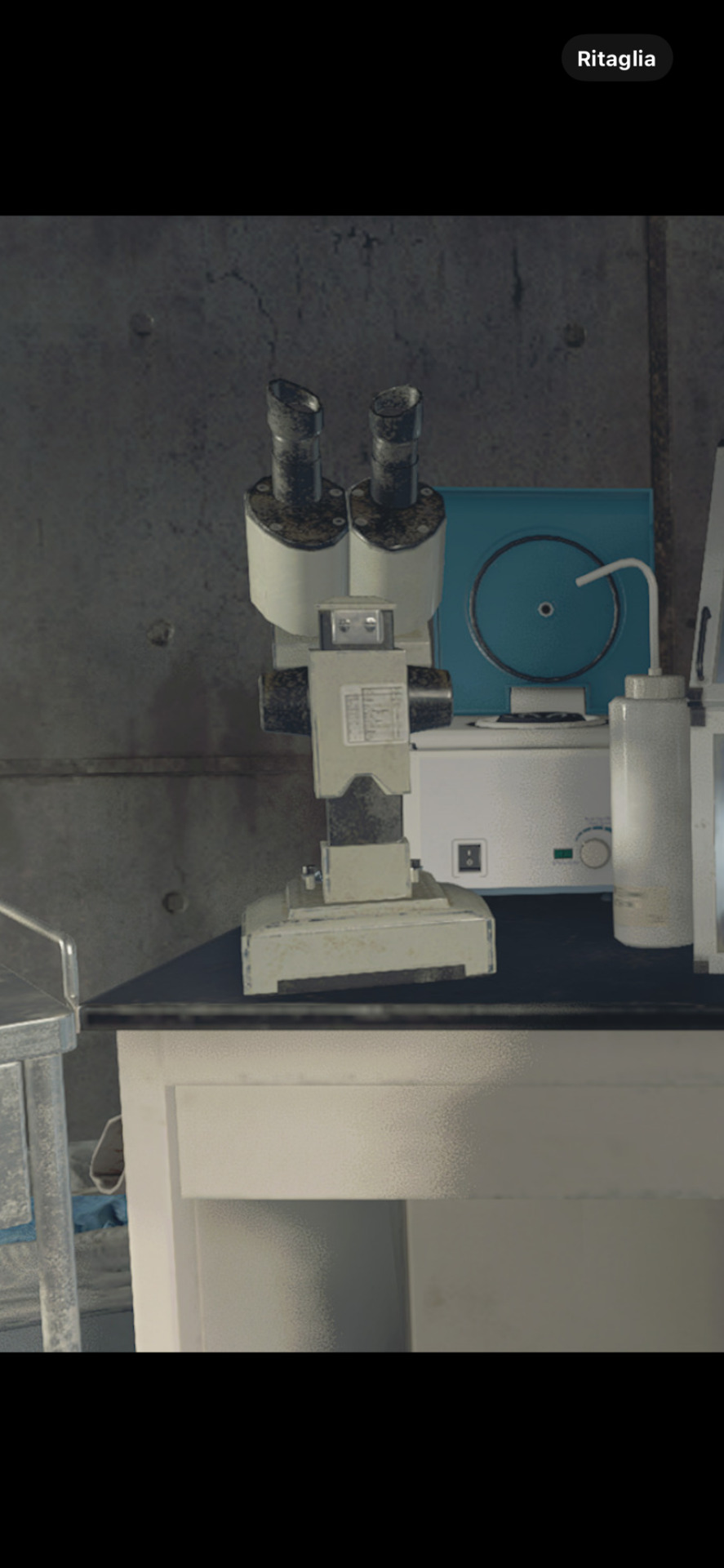

I’m sure everyone recognizes this one but still wanted to add the picture from my lab because I appreciate how detailed and accurate his equipment is
4. Shaking incubator
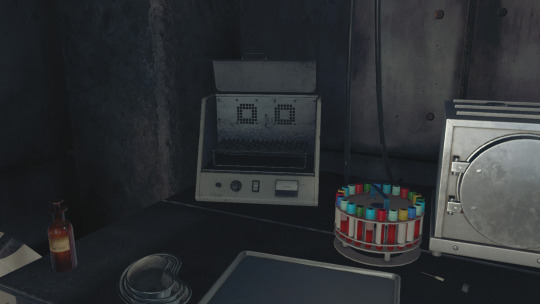

Used to grow tubes of cells! They are typically kept at 37C (body temperature) and they shake at like 200rpm to keep oxygen flowing through the culture so they stay healthy. You would do this to grow samples of whatever organism you desired so you could run experiments on it the next day (we call it making overnights or overnight cultures).
5. Maybe an anaerobic chamber?
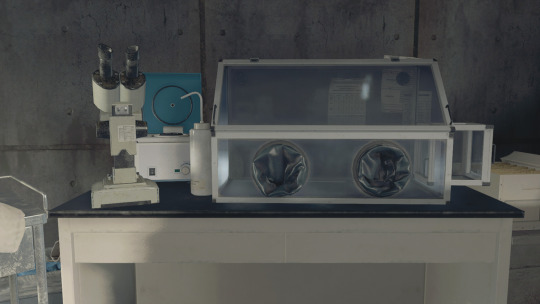

These are slightly less common pieces of lab equipment so I was surprised to see it! We have one in our lab because we do some work on gut-dwelling bacteria that have to be grown without oxygen. As you can see, ours looks a little different so it might have some different uses, but generally the little cube on the right side is where you would place a sample (it’s an airlock) and then transfer it into the chamber. Seeing as Luis has it, I’m thinking maybe las plagas might need to be grown anaerobically at certain stages, I’d guess in early life when it’s really dependent on being in the human body.
I've got some other pictures to compare that I'll also be posting about in the coming days, about things like chemical management plus some other weird equipment things Luis has, but in the meantime if you have specific questions feel free to DM me! I hope this is helpful!
92 notes
·
View notes
Note
Nobody bays an eye at the fact that MK's mom is a very much male presenting person. They live in a world where shape-shifting is the norm, and there is literally a famous story about a kingdom with a river that can make anyone, no matter the gender, pregnant. Its not an impossible thing to imagine for them, especially since they suspect MK to be a demon at that point anyway, which means his mom is guaranteed to be one too. No, the biggest surprise in regards to Wukong's pregnancy comes more from who Wukong is rather than any sort of gender he presents as, but it's rather easily explained away. After all, there's no reason for Wukong to hide the fact that Stone Monkey pregnancies are often fatal and result in many complications, so as the stronger and more durable between himself and his mate as well as the one with mor most layers of immortality, it's simple logic that he'd be the one to bear their young.
At least, that's how Wukong describes it later. What he neglected to realize is that just because the specifics of Stone Monkey pregnancies have become somewhat common knowledge amongst the celestials, the mortals do not share in that knowledge and hus rather blase attitude in regards to potentially dying in childbirth does little to ease DBK, Pigsy, Tang, or Sandy's concern. PIF is a little more understanding of Wukong's position, having gone through similar complications with Redson's birth, and actually applauds his willingness and bravery in bringing more children into the world, even whilst almost losing his life to bring his eldest into the world.
prev post.
That and they don't want to assume anything in case MK's mom is a trans person. Wukong is fine with both Mama/Baba titles, and if he carried the kid it only makes sense to him to be "Mom" to them.
In a world of demons, trans people, shapeshifting, and rivers that make your pregnant, you just grow up knowing that sometimes a dude gets pregnant.
Regular Stone Monkey pregnancies aren't anymore fatal than say wild monkey statistics, but the Stone Egg method is super dangerous. Stone Monkeys basically donate so much of their life energy to the world around them that there's very little left over for themselves. The "Boulder" atop FFM is even described as spreading orchids and mushrooms into the earth around it.
PIF admires and envies Wukong a little for his success, despite the terror surrounding little Xiaotian's arrival. She wonders if DBK hadn't been imprisoned, if they could have had such luck.
Wukong very simply explains to the Noodle Gang that he's like the healthiest demon around, and his mate is slightly more fragile than him (literally born in the anaerobic enviroment of the moon = no immune system), so he takes over for baby-incubating. The gnag are super intrigued!
Tang: "So when did you decide to have MK?" Wukong, laughing: "Oh, that was a happy accident! A happy, kinda-scary, 14 year accident." Noodle Gang: (*all nod on understanding/awkwardness*) MK: "Yeah, thats why I grew up being told never to bury myself under a mountain." Noodle Gang: "...wut?" Tang:, JTTW brain activating: "Wait. Did you say 14 years!? As in during the Journey!?!"
Wukong pretty much pulls out corkboard of crayon drawings (like in "The Plan Man") to explain the process and how Macaque accidentally left Wukong "rock pregnant" under Five Finger Mountain - a collage crafted specifically back when MK had first asked about the "Birds and the Bees". The Noodle Shop Gang are horrified - and so is MK for having to re-live it.

Everyone comes away from that specifc lunchtime knowing a little too much about the reproductive habits of Stone Monkeys.
Hilariously I can imagine a situation like with the Eclipse Twins in the TMKATI au (both monkeys got el-pregante with either twin) happening here.
But with the current day. Remember how I pointed out that out of all the Nodelets, one shadow planet was missing? >:3
Once the LBD situation is dealt with at the end of S3;
Guanyin: (*gently grabs Macaque by the scruff of the neck*) Guanyin: "How long were you going to run around getting into danger without telling him [Wukong] you were expecting as well?!" Macaque, honestly confused: "Pardon???" Wukong: (*GASP!*) "Hypocrite!" Macaque: "In my defence, I didn't know that could happen."
MK barfs just *a little* at the announcement (MK: "I TOLD you they were being gross!").
Que the last Lunar Nodelet; Ziqi being made. This time via a very nervous Macaque.
Shadow monkey is on 24 hour lockdown pretty much to watch out for health complications, a reasonable punishment for his little disappearing act. Complications arise only because Mac was away from FFM for an appointment with Lao Tzu when a certain Scroll got found...
#post jttw stone egged au#jttw stone egged au#pregnancy mention tw#sun wukong#six eared macaque#shadowpeach#liu er mihou#lmk pif#lmk princess iron fan#lmk aus#lmk#lego monkie kid
58 notes
·
View notes
Text
Listeria
For whatever reason it reminds me of Desperate Housewives and Wisteria lane. Or just Wisteria in general.

It's unfortunately it's anything but wistful or romantic.
This is inspired by the netflix series Poisoned. I hate that title but it's a great watch. I learned a lot from it. I highly recommend it particularly for medical students and residents etc.
So, listeria are gram positive rods (most bacilli are negative) making this relatively easier to remember (purple rods). Also catalase positive. IT's also a facultative anaerobe - so both cultures may be positive (aerobic and anaerobic bottles).

the species that is the culprit for major human pathogens is Listeria monocytogenes.
At increased risk groups (more likely to die of Listeriosis) - the immunocompromised and extremes of life, including the elderly, pregnant women and neonates. Immunocompromised: HIV, anyone on long term highish doses of steroids, leukaemia/oncology patients etc. Worryingly, incubation time is 3-90 days in these groups, so it's difficult to really trace or keep track of. Pregnant women are at 20x higher risk of acquiring the severe form.
Source: CDC

Hence why during pregnancy you're advised not to consume raw salads, fruits, cold cuts, soft cheeses, sprouts and smoked salmon or sushi, no mayo and no raw egg (definitely no raw milk) etc. Similarly, common recommendation is you serve none of these to children under the age of 1. It naturally lives in soil (hence avoidance of raw sprouts) and can live in animals. So it can frequently contaminate food.
Image Source: SA Health

As with COVID (I can't believe I'm using COVID as a measure of things), it can cause mild food borne illness (nausea, vomiting diarrhoea, myalgias, even fevers) to invasive disease causing sepsis and even meningitis or encephalitis. Incubation time is a few days in the mild form.
IMage source:
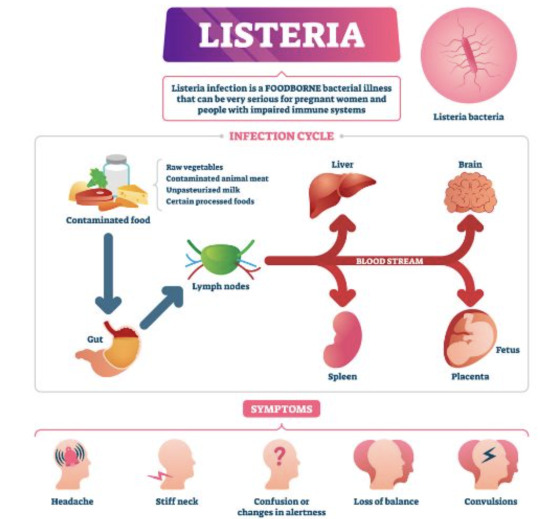
Death by Listeria when you have the severe form (Listeriosis) is 20%, astonishingly high given you have a 1% chance of dying from Salmonella.
It's a small risk but the issue is that complications and fatality if you do acquire is high. It's also highly preventable, but the challenge is food safety and avoiding certain foods as a consumer.
i.e. in pregnancy, most will have diarrhoeal illness that's mild. But in the subset that get invasive disease and really unwell, there's a 20% risk of miscarriage, risk of premature labour and risk of still birth at 3% in the US. In the states, pregnant women are also 10x more likely to get Listeria infection. That is, illness after exposure.
On the final note of prevention, also always properly refridgerate food to 4 degrees celsius and cook meat to 165 fahrenheit or 73 degrees celsius. As I've learned from the Poisoned documentary, you can ask restaurants to do this, ask them to use an internal thermometer to measure - as rare/medium rare etc have no meaning as it pertains to food safety. If they can't, order something else.

With meningoencephalitis, we just presume that Listeria is a possibility and treat empirically while awaiting investigations.
Investigations: - CSF (lumbar puncture) in event of signs of meningism or encephalitis (classic headache/fever/stiff neck/rash and/or acute confusion or seizure AND fevers) --> expect the classic features of bacterial meningiits and gram stain positive for purple rods - PCR - stool cultures have no value - blood cultures--> look for gram positive rods in the preliminary findings, expect a call from the lab Empirical therapy: - none in asymptomatic or mild disease. just monitoring until symptoms resolve and supportive care (fluids etc.) - Listeria is a notifiable disease to the health department in most Western countries that keep track of outbreaks. - in the US, standard treatment is ampicillin. - in Australia at least, standard therapy is IV benzylpenicillin, 2.4 g 4 hrly in meningitis or encephalitis and everyone is just started on this until bug identification/gram staining and sensitivities return. - in hypersensitivity, bactrim is used. - cephalosporins have no activity against them (or "inherently resistant), hence you can see IV ceftriaxone and benzylpen in the drug regimen for empirical therapy of meningitis - cef covers gram negatives, strep pneumo (most common cause of meningitis) and neisseria meningitidis - duration of therapy in severe disease: 3 weeks, 6 weeks if immunosuppressed
Really great summary here.
Random historical trivia
listeria is named for Dr. Joseph Lister, a British surgeon who introduced sterilisation of equipment and antiseptics to surgery, improve post op care and observed that microbes are the cause of cases of poor wound healing or post op infections. he also began to look at them under the microscope as an early pioneer of bacteriology.

Lister's father by the way, made compound microscopes for a living, so lister became proficient at using this and started publishing articles during medical school
this also led to a lot more research on inflammation and coagulation
weirder trivia: in his med school days, surgeons commonly did not wash hands between patients and some didn't even change gowns, glorifying how busy they where by how many stains were on it by the end of the day

so unsurprisingly his early battles to pioneer antiseptics and aseptic techqniues to prevent the transmission of infection in surgical patients were pretty uphill
Resources CDC guidelines WHO guidelines FDA Statpearls --> great at covering basic physiology and pathology etc. in a short form. Australian therapeutic guidelines - unfortunately not free.. so won't bother to link. If you work at any large-ish Australian hospital you'll have 'free' access. Wikipaedia US list of outbreaks CDC recommendations on foods to avoid vs okay to eat to avoid Listeria
7 notes
·
View notes
Text
Anaerobic Incubator LAI-B10
Labtron Anaerobic Incubator features an LCD display and dual functionality as an anaerobic or micro-oxygen chamber. With a 304 stainless steel shell, it offers precise control of CO2, humidity and temperature RT + 3°C to 60°C. Equipped with automatic gassing systems and an external vacuum pump, it creates anaerobic conditions <1% O2 in under 1 hour, ensuring a strict anaerobic environment for scientific applications.

0 notes
Text

Labtron Anaerobic Incubator, with an LCD display, operates as both anaerobic and micro-oxygen chambers. It features CO2 control (0-20%), temperature range RT+3°C to 60°C, humidity control (50-90% RH), UV sterilization, and can transfer 40 plates at once.
0 notes
Link
1 note
·
View note
Text

Anaerobic Incubator is meticulously engineered to create and maintain an environment devoid of oxygen, crucial for the cultivation and study of anaerobic microorganisms. The temperature range inside the chamber can be maintained from RT+3 to 60℃ with a microcomputer control system. This unit is tailored to ensure a consistently anaerobic environment, prioritizing both the integrity of experiments and operator safety.
0 notes
Text
Anaerobic Incubator

Labtron Anaerobic Incubator is designed for culturing anaerobic microorganisms, featuring a microcomputer control system, UV sterilizer. It achieves anaerobic conditions in under 5 minutes, operates at RT+3 to 60°C, and includes safety features like leakage protection, an overheating alarm
0 notes
Text
Petri Dish: A Novel Approach to Microbiology Exploring the Utility of This Useful Tool

What is a Petri Dish?
A Cell culture dish, also known as a Petri plate or culture dish, is a shallow circular glass or plastic dish that has a lid and is used to hold solid or semi-solid culture media. The most common type of Cell culture dish is an 88-100 mm diameter round dish made of clear polystyrene or glass. The lid is made of an inert transparent material like plastic or glass so that microbial growth inside can be easily monitored under a microscope. History of the Petri Dish
The Cell culture dish was invented in the late 19th century by German bacteriologist Julius Richard Petri as a reproducible and standardized device for growing microorganisms under controlled conditions. Prior to the invention of Cell culture dishes, biologists would use hanging drop preparations or flasks and jars, which made it difficult to isolate and count individual colonies. Petri realized that being able to uniformly disperse nutrients over a sterile flat surface would allow precise analysis of bacterial growth. His design revolutionized microbiology research by enabling microbial cultures to be easily maintained and studied. Uses of the Cell culture dish
Cell culture dishes are ubiquitously used in microbiology labs for culturing and counting microbial colonies. Some common uses include: Bacterial Isolation and Colony Counting
To study bacteria in a pure culture, a small amount of nutrient medium is poured into a sterile Cell culture dish and allowed to solidify. Then, a sample containing the bacterial culture is spread or streaked over the surface and incubated. Individual bacteria will grow into visible colonies that can be isolated and studied separately. Cell culture Petri Dish enable precise quantification of colony forming units. Microbial Growth Studies
By varying conditions in Cell culture dishes like temperature, pH, gas composition, and nutrient levels, microbiologists can study how these environmental factors affect microbial growth rates and patterns. This helps characterize optimal growth requirements of different microbes. Antibiotic Sensitivity Testing
Antibiotic sensitivity of bacterial isolates can be determined by growing them on an agar plate containing antibiotic discs or gradients. The size of inhibition zones around the discs indicates whether the bacteria are susceptible or resistant to that drug. Microbial Interaction Studies
Co-culturing two different microbes on the same agar surface enables studying phenomena like symbiosis, competition, and antimicrobial activity between species. Presence or absence of distinct growth zones reveals if there is inhibition or stimulation between the interacting organisms. Types of Media Used in Cell culture dishes
Depending on the microbes being cultured and purpose of experiment, Cell culture dishes can contain different solid culture media that provide optimal growth conditions. Some commonly used media include: Nutrient Agar
A general purpose medium made with peptones and meat extract that supports the growth of non-fastidious bacteria. Nutrient agar plates are often used for initial culturing of clinical and environmental samples. Blood Agar
Also known as Columbia agar or CNA agar, blood agar contains added blood to detect microbial haemolysis (breakdown of blood cells). This helps differentiate bacterial species based on their hemolytic patterns. MacConkey Agar
A bile salt-containing selective medium that inhibits most gram-positive bacteria and fungi, allowing isolation of gram-negative enteric bacteria. Lactose/sucrose fermenters in a sample can be distinguished on MacConkey agar. Sabouraud Dextrose Agar
An acidic formulation containing peptones and dextrose, used for culturing fungi and yeasts. Mold colonies can be easily distinguished from bacterial growth on SDA plates. Thioglycolate Broth
A reduced nutrient medium for culturing fastidious and anaerobic microbes. When poured into test tubes or deep dishes under mineral oil, it provides an oxygen-depleted environment for growth of strict anaerobes. Applications of Microbial Culture in Cell culture dishes
Overall, the simple yet effective design of the Cell culture dish has made it one of the most indispensable tools in microbiology. It enables routine lab procedures like sampling, isolation, quantification and identification of microbes from various sources.
the controlled growth conditions of petri plates also aid mechanistic studies on fundamental aspects of microbial physiology, genetics, and ecology. Advances like automated colony counters have further expanded applications of Cell culture dish cultures in fields like food/water testing, medicine and biotechnology. Hence, this humble glassware continues making significant contributions to our understanding of the microbial world.
Get more insights on Petri Dish
About Author:
Ravina Pandya, Content Writer, has a strong foothold in the market research industry. She specializes in writing well-researched articles from different industries, including food and beverages, information and technology, healthcare, chemical and materials, etc. (https://www.linkedin.com/in/ravina-pandya-1a3984191)
0 notes
Text
Anaerobic Incubator

Labtron Anaerobic Incubator is designed for culturing anaerobic microorganisms and features a microcomputer control system and UV sterilizer. It achieves anaerobic conditions in under 5 minutes, operates at RT+3 to 60 °C, and includes safety features like leakage protection and an overheating alarm.
0 notes
Text

Labtron Anaerobic Incubator with a micro-computer control system, UV sterilizer, and stainless steel chamber for a safe and efficient anaerobic environment. anaerobic state in < 5 minutes with a temperature range of RT+3 to 60°C. Plus, ensure operator safety with features like latex gloves and leakage protection.
0 notes
Text
anaerobic chamber
The NAC-100 anaerobic chamber is perfect for laboratories where the growth and identification of bacteria need the absence of oxygen. The incubator is designed with a double widen door in a way that it can put more petri dishes. The product is equipped with leakage protection.

0 notes